How to Stay Compliant: New York Cannabis Laws for Home Growers
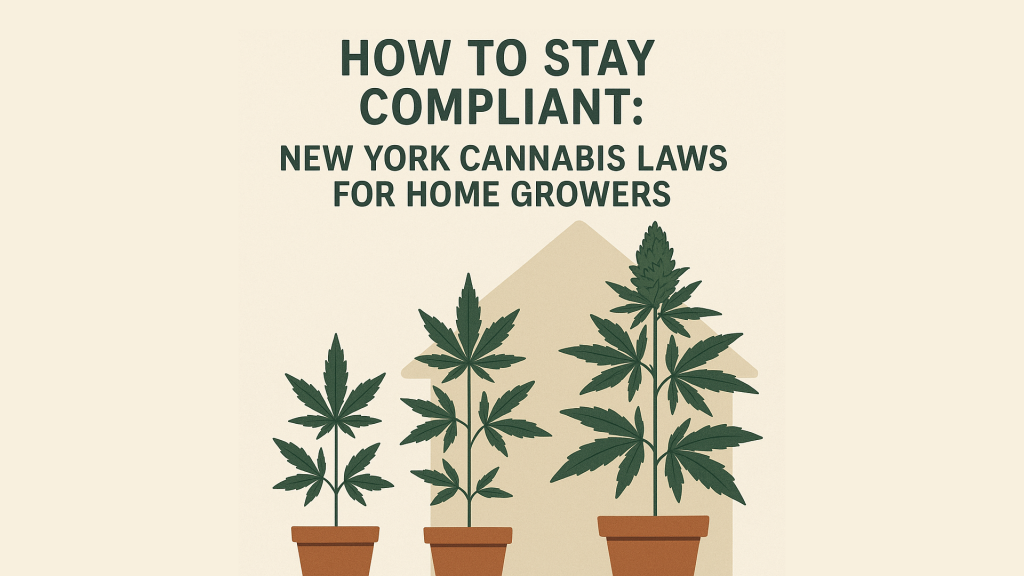
Understanding New York’s Cannabis Laws
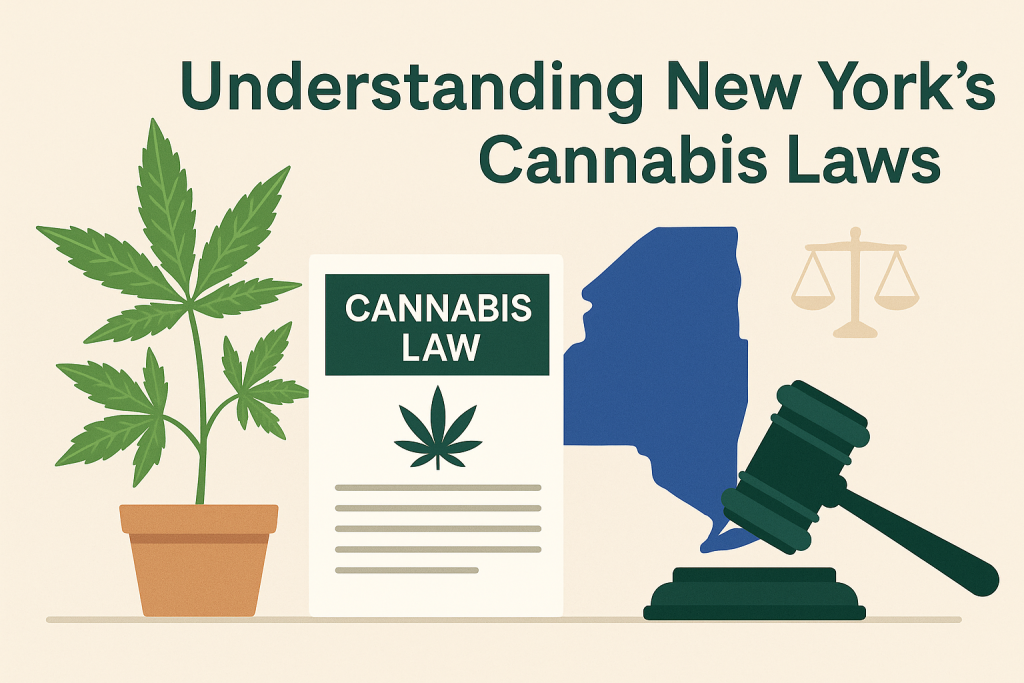
What Changed After Legalization in New York
When New York cannabis laws changed in 2021, everything shifted. Before that, having or growing marijuana could get you arrested. Now, if you’re 21 or older, you can legally have it—and even grow it at home. But that doesn’t mean there are no rules. There are still strict limits on how much you can grow, where you can grow it, and how you store it.
The law that made this all happen is called the Marijuana Regulation and Taxation Act or MRTA. This act made adult-use cannabis legal across New York State. It also gave people the right to grow their own cannabis plants at home, under certain rules.
Before MRTA, cannabis laws in New York were confusing. Medical marijuana was allowed, but only with strict doctor approval and no growing at home. Now, the law is easier to understand, especially for those wanting to grow for personal use.
Here’s how the law evolved:
| Year | What Happened |
|---|---|
| 2014 | Medical marijuana legalized for patients with serious conditions. |
| 2021 | MRTA signed, legalizing recreational marijuana. |
| 2022 | Possession limits set, grow-at-home rules introduced. |
| 2023 | Office of Cannabis Management began licensing and regulating. |
These new rights came with new responsibilities. Even if you’re growing at home just for yourself, you must follow the exact rules. Getting it wrong could mean fines or worse.
The Difference Between Recreational and Medical Cannabis Rules
Even though both recreational and medical cannabis are legal, the rules are different.
If you’re using marijuana for medical reasons, you must be certified by a doctor and added to New York’s Medical Cannabis Program. You also have a registered caregiver if needed. You can grow cannabis, but you have to be either the patient or the caregiver.
For recreational users, you just need to be 21 or older. But the number of plants you can grow is limited and you can’t sell or give away large amounts.
| Feature | Medical Use | Recreational Use |
|---|---|---|
| Age Required | Any (with doctor approval) | 21+ |
| Grow Limit | Up to 6 plants per person | Up to 6 plants per person |
| Can Have Caregiver | Yes | No |
| Need a Doctor | Yes | No |
| Home Grow Rules | Allowed with registry | Allowed with age and residency proof |
The biggest difference is oversight. Medical users are tracked by the Office of Cannabis Management (OCM). Recreational users don’t register, but still must follow strict growing rules.
Who Regulates Cannabis in New York
The agency that makes the rules and checks if everyone follows them is the New York State Office of Cannabis Management (OCM). They’re in charge of everything related to cannabis in the state—medical, recreational, and growing.
The OCM’s job includes:
- Setting plant and possession limits
- Approving licensed sellers
- Giving out growing permissions for commercial use
- Educating the public
- Helping people understand their rights
They also create guides and FAQs for home growers. If you’re ever unsure, visiting their site is the best way to get official answers. If the OCM updates a rule, it becomes law. It’s important to check regularly to avoid breaking a rule you didn’t know changed.
Here’s a list of who does what:
| Group | Role |
|---|---|
| OCM | Oversees all cannabis laws |
| NYS Police | Enforce laws when people break them |
| Local Towns | May add extra rules like zoning or permits |
| Medical Providers | Approve patients for medical use |
Even though cannabis is legal, it’s not a “do whatever you want” situation. It’s more like driving—you have the right to do it, but only if you follow the signs and signals.
How These Laws Impact Regular People
For everyday people, understanding New York cannabis laws makes all the difference between safe and legal—or risky and fined.
Let’s say you’re 22 and live in Binghamton. You want to grow cannabis at home. That’s legal now, but:
- You can’t grow more than six plants.
- You can’t grow outside unless no one can see them.
- You can’t sell or even trade it.
If you grow too many or let your neighbor take a few buds, that’s considered illegal distribution.
Or maybe you rent your apartment. Even though the law says you can grow, your landlord might say no. They can ban growing in your lease. That’s a civil issue, not a criminal one, but it can still cost you your home.
A real quote from a New York grower on a cannabis community forum:
“I thought because the law changed, I could grow anywhere. My landlord found my tent and now I’m being evicted. Read your lease before you plant anything.”
So while the laws do protect your right to grow, they don’t give you a free pass everywhere. You have to know the fine print.
Here’s a quick checklist for people thinking about growing:
- ✅ Are you 21 or older?
- ✅ Do you live in New York?
- ✅ Are you growing only for yourself?
- ✅ Is your grow space private and secure?
- ✅ Are you under the plant limit?
If you answered yes to all five, you’re off to a good start.
Growing at home can save you money and give you control over what you consume. But just like driving a car, you need to know the rules before you hit the gas. That way, you stay on the safe and legal side of this new freedom.
Understanding New York cannabis laws helps you avoid mistakes that could cost you your grow—and maybe your record. Always stay smart, stay informed, and stay within the law.
Who Can Legally Grow Cannabis at Home
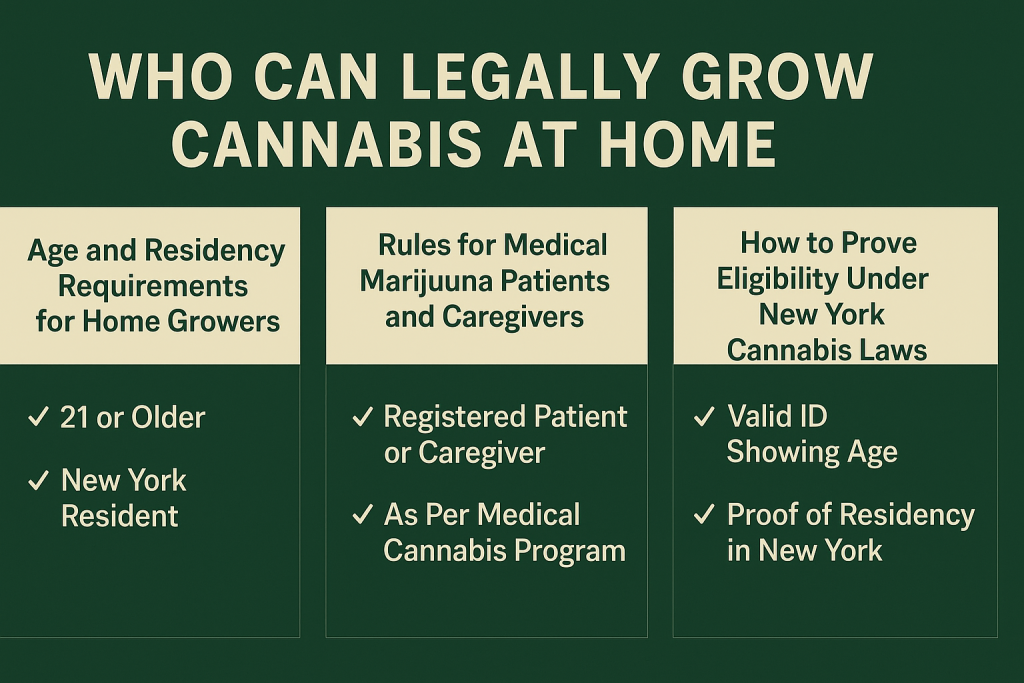
Age and Residency Requirements for Home Growers
To legally grow marijuana at home in New York, the first thing that matters is your age. You must be 21 years old or older. If you’re 20 or younger, no matter your situation, you can’t grow—period. That part of the New York cannabis laws is strict and clear.
You also have to live in New York State. It’s not enough to just be visiting, even if you’re here for a few months. You need to show that this is your real home.
There are two parts to meeting the state’s grow-at-home rules:
- Your age must be 21+
- You must prove that New York is your permanent home
If one of these is missing, you’re not legally allowed to grow cannabis—even if you’re not planning to sell or share it.
| Requirement | Must Be Met? | How to Prove |
|---|---|---|
| Be 21 or older | ✅ Yes | State ID, Driver’s License, Passport |
| Live in New York | ✅ Yes | Utility bill, Lease, Mail, NYS ID |
This makes it super clear—if you’re under 21 or living out-of-state, growing is off-limits.
Rules for Medical Marijuana Patients and Caregivers
The rules are slightly different if you’re a medical marijuana patient or a registered caregiver.
If you’re a certified patient through the New York Medical Cannabis Program, you can grow your own plants for your personal use. But you still have to follow plant limits and storage rules. You can’t just grow a ton of plants because it’s for your health.
Caregivers can also grow—but only for patients they are assigned to. They can’t grow for themselves unless they are also certified patients.
This is how it breaks down:
| Role | Grow Allowed? | Max Plants | Notes |
|---|---|---|---|
| Certified Medical Patient | ✅ Yes | 6 per person | Must be officially registered |
| Caregiver | ✅ Yes | 6 per patient | Only if growing for assigned patient |
| General Public | ✅ Yes | 6 per person | Must be 21+ and NY resident |
A caregiver who’s growing for a patient has to keep the plants in a place that’s safe, locked, and labeled. This helps prevent confusion with recreational growing, which follows different paths.
Quotes from medical cannabis forums show how important clarity is:
“I’m a caregiver for my brother. I had no idea I could grow for him legally until I asked his doctor. Now we keep a small tent in the basement with everything labeled. No problems so far.”
That extra step of being registered with the medical program is key. Without it, you’re just another person with plants.
How to Prove Eligibility Under New York Cannabis Laws
Even if you’re old enough and live in New York, you still need to prove it. That means you should have documents ready that show both your age and your residency.
Here are documents that work:
| Proof Type | Examples |
|---|---|
| Age | Driver’s license, passport, state ID |
| Residency | Lease agreement, utility bill, voter registration, pay stub with address |
Having a valid New York State ID usually checks both boxes at once. But if you’re using a passport from another state or country, you’ll need something else to show you live in NY.
It helps to keep these documents somewhere safe. If you ever get asked to show you’re following the law, it’s better to be ready than scrambling.
Here’s a helpful list of what you should keep:
- Copy of your state ID or license
- Copy of your lease or mortgage statement
- Recent utility bill with your name and NY address
- If you’re a medical patient: certification email or card
- If you’re a caregiver: official caregiver registry proof
Even though no one is going door-to-door checking IDs, these rules are real. If something happens—like a neighbor complains or a landlord asks questions—having proof could keep things calm and legal.
Some local towns or cities may ask for even more, especially if you’re growing in a multi-unit building. That’s why it’s a smart move to check your local rules, too. You can usually find updates through your local government website or by visiting your county clerk’s page.
Many home growers forget that just because it’s legal at the state level doesn’t mean it’s okay in every town or building. That’s where zoning laws and lease rules come into play.
It’s smart to talk to your landlord, too. Here’s a sample quote from a user who lives in a NY apartment:
“I live in a small rental in the Bronx. I showed my landlord the law and asked if I could grow. He said yes, as long as I keep it out of sight and follow building codes. Having it in writing helped.”
The more steps you take to prove your eligibility, the more peace of mind you’ll have while growing your own. The focus keyword New York cannabis laws exists to give you this kind of path—freedom, with structure.
Growing your own cannabis is legal in New York now, but only for the people who meet the age and residency rules. Medical patients and caregivers have a little extra freedom, but they also carry more responsibility.
Anyone looking to get started needs to double-check that their ID, living situation, and paperwork are all in place. If you’re 21 or older and you call New York home, then you’re probably already halfway there.
How Many Plants You Can Grow in New York
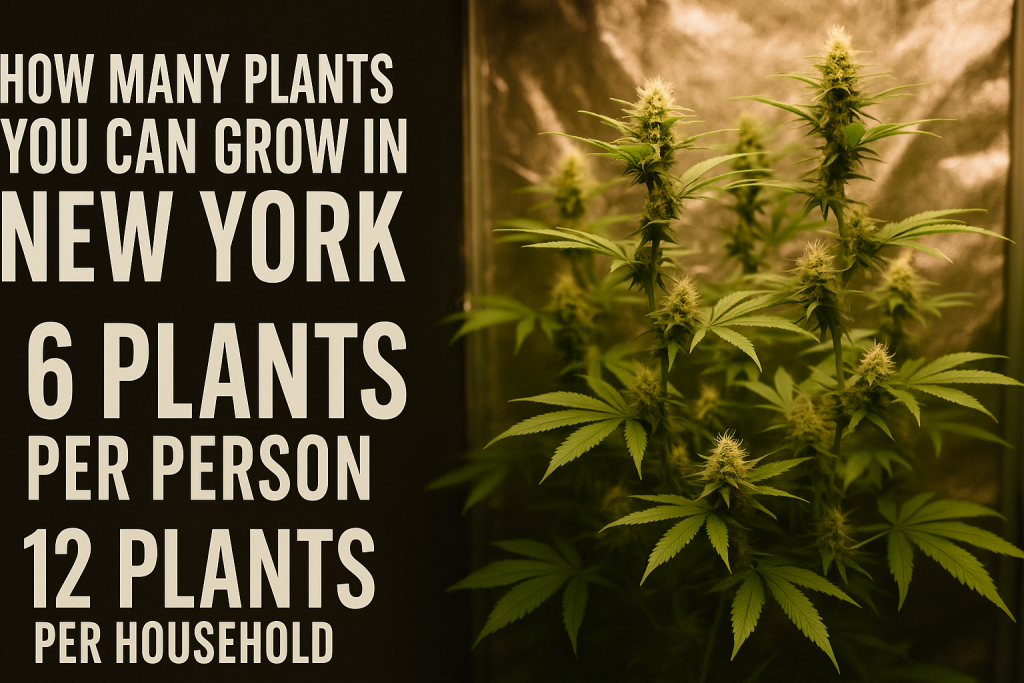
The Legal Plant Limit for Personal Use
Under New York cannabis laws, adults 21 and older can legally grow cannabis at home. But there’s a hard limit on how many plants you’re allowed to grow, and going over that number can get you into trouble. The rule is six plants per person, but there’s more to it.
Each person can grow:
- 3 mature plants (blooming and ready to harvest)
- 3 immature plants (still growing and not flowering)
That means a total of 6 plants per adult, but not all of them can be flowering at once. If you’re part of a household with multiple adults, you can grow up to 12 plants total in that one home. Still, it breaks down the same—only half can be mature at one time.
| Household Size | Mature Plants | Immature Plants | Total Plants |
|---|---|---|---|
| 1 Adult | 3 | 3 | 6 |
| 2 or More Adults | 6 | 6 | 12 |
The law doesn’t care who’s growing which plant. As long as you don’t go over the max for your home, you’re okay.
This gives people some freedom but sets clear lines. It’s meant to keep personal growers from becoming unlicensed sellers.
The Difference Between Mature and Immature Plants
Not all cannabis plants are created equal. The law treats mature and immature plants differently. That’s why knowing the difference really matters.
- Mature Plants have buds. They’re flowering, strong-smelling, and almost ready to be harvested. These are counted more seriously by law enforcement.
- Immature Plants are still growing. They don’t have buds yet and aren’t ready to be used. These are still counted, but with more flexibility.
Here’s how to tell them apart in real life:
| Feature | Immature Plant | Mature Plant |
|---|---|---|
| Height | Short to Medium | Taller |
| Buds Present? | No | Yes |
| Smell | Mild or none | Strong, pungent |
| Leaves | More fan leaves | Dense with flowers |
| Harvestable? | Not yet | Almost or fully ready |
Let’s say you’re growing three plants and all are leafy but have no buds. That means they’re immature. You’re still within the law. But once they start flowering, you’ve got to count them as mature. You can’t have more than three of those if you’re the only adult in the home.
Growers often rotate their plants. That means starting new ones while others are flowering, but never going over three mature at a time. This method keeps you within legal limits while still keeping your supply steady.
A New York grower shared online:
“I mark my plant tags red or green. Red means mature. Green means immature. It keeps me honest and legal if anyone ever checks.”
That kind of system can help more than you’d think.
What Happens If You Exceed the Limit
Growing more than you’re allowed under New York cannabis laws can bring serious consequences—even if you’re just doing it for yourself.
You could face:
- Fines
- Confiscation of your plants
- Criminal charges if it looks like you’re selling
Once you go over the limit, law enforcement may treat it as illegal cultivation. And if they believe you’re growing to distribute or sell, you could be charged with a felony. That’s true even if you’re not making money from it.
Here’s a list of what can raise red flags:
- More than 3 mature plants per adult
- More than 6 mature plants in one home
- No signs of personal use (like labels or secure storage)
- Large grow lights or industrial equipment
- Neighbors complaining about smell or traffic
If officers visit and see 14 plants, all fully flowering, they’re not going to assume it’s for you and your roommate. That’s why it’s important to keep your grow operation small and clearly for personal use.
A real-world scenario helps explain it better:
| Situation | Risk Level | Likely Result |
|---|---|---|
| 2 adults, 12 plants (6 mature) | ✅ Legal | No action |
| 1 adult, 10 plants (5 mature) | ❌ Illegal | Warning, fine, or worse |
| 3 adults, 12 mature plants | ❌ Illegal | Over limit, likely fine or seizure |
| 2 adults, 12 total (only 3 mature) | ✅ Legal | Safe |
You can avoid issues by tagging your plants, documenting your grow dates, and staying organized. It’s not required by law—but it shows you’re following the rules on purpose.
You also need to watch your harvest weight. Even if your plant count is legal, storing too much dried cannabis could break a different rule. That’s covered by separate limits.
Some people try to “game the system” by claiming friends live with them to raise the household limit. But if law enforcement investigates and finds the person doesn’t really live there, it could lead to bigger problems.
The best move? Keep it clean, clear, and honest.
If you’re new to growing, it’s helpful to write out your plant plan:
- Date planted
- Type (strain)
- Stage (immature or mature)
- Expected harvest window
- Storage details
That way, if anyone questions you, you’ve got the details written down. And if you’re in a shared living space, this helps prevent mistakes that could push you over the limit.
You’re allowed to grow your own marijuana now, but only if you stay within the legal lines. The focus keyword New York cannabis laws exists for this exact reason—to give everyday people a real path to grow safely and without fear.
Where You Can Legally Grow Cannabis at Home
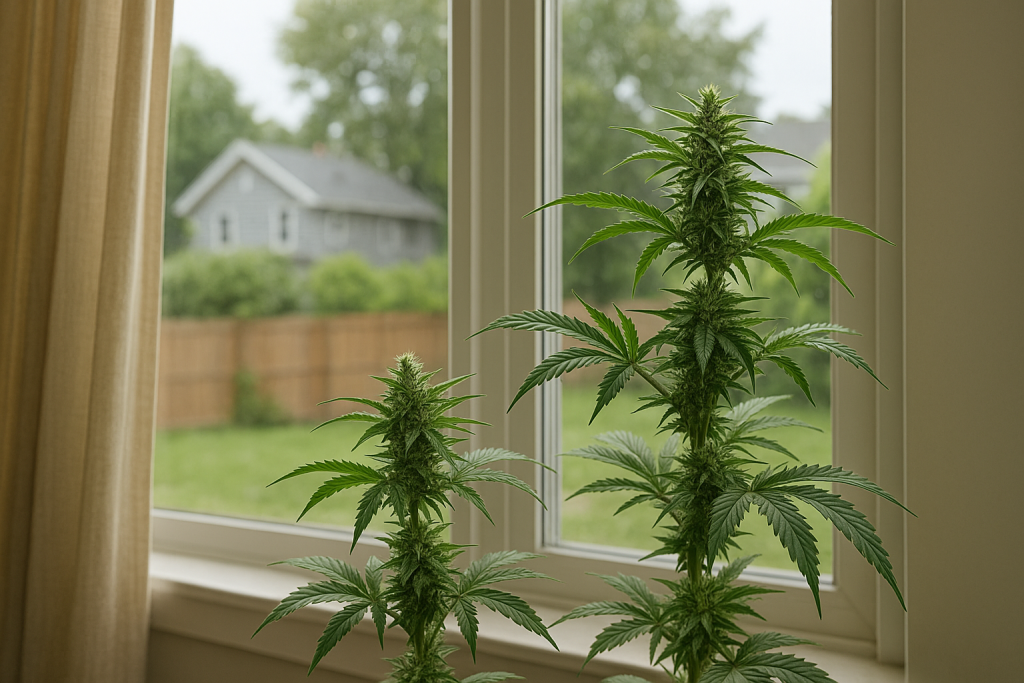
Indoor vs. Outdoor Growing Rules
When it comes to where you can grow your cannabis, New York cannabis laws give you some options. You can grow indoors or outdoors, but the key is making sure your setup is legal and private.
Growing indoors is the most popular. It’s easier to keep control of your light, temperature, and humidity. It also helps avoid unwanted attention from neighbors or the public. You can use a tent, a closet, or even a spare room—as long as it’s locked and out of sight.
Outdoor growing is allowed too, but it must follow stricter privacy rules. The plants must not be visible to the public. That means your backyard has to be enclosed—like with a fence—and your plants can’t be seen from the street or sidewalk.
Here’s a side-by-side view:
| Growing Type | Allowed? | Must Be Hidden? | Other Requirements |
|---|---|---|---|
| Indoor | ✅ Yes | No, but should be private | Lock the room or tent |
| Outdoor | ✅ Yes | ✅ Yes | Fence, no street view, secure space |
If someone walking by can see your plants, it could lead to problems. Police may treat it as a public safety concern or possible distribution risk.
Some towns may also ban outdoor cultivation altogether, so always check your local laws. Just because the state allows it doesn’t mean your town does.
One grower from Syracuse shared:
“I had to move my plants inside after the city passed an ordinance. I didn’t know until I got a warning letter from the housing inspector.”
That’s why it’s smart to start indoors if you’re unsure.
Keeping Plants Secure and Out of Public View
Whether you grow inside or out, keeping your cannabis secure is part of staying within New York cannabis laws. That doesn’t mean you need a bank vault—but you do need a locked space.
The law says plants must be in a secure location. That means:
- Behind a door that locks
- In a fenced-in yard (if outside)
- Not visible to the public or passersby
If your plants are in a garage, make sure it’s locked. If they’re in your backyard, put up a tall privacy fence. If they’re in a grow tent, zip it closed and lock the zippers with a mini lock.
For apartments or shared homes, indoor setups are better. They help keep your plants away from others, including kids, roommates, or guests.
Some grow tents come with lock-ready zippers, and even fireproof linings. Those little details can make a big difference if your grow is ever inspected.
Here’s a simple checklist for plant security:
- 🔒 Lock on door or tent
- 🌿 Plants not visible from any window facing a public area
- 🧒 No access to children or visitors
- 🔌 Safe use of power and lights
- 🧾 Proof of residence and age nearby
If law enforcement visits, showing that you’ve taken all the right steps can help a lot. It shows you’re not trying to break the rules—you’re following them with care.
Homeowners vs. Renters: What You Need to Know
Owning your home makes things a lot easier when it comes to growing. If you’re a homeowner, and you meet all the age and plant rules, you can grow without needing permission from anyone else.
But if you’re a renter, things can get tricky. Even though New York cannabis laws allow personal growing, your lease agreement can override that.
Landlords can legally say:
- No growing allowed
- No cannabis on the property
- No strong odors or ventilation changes
If you grow in a rented apartment or house without permission, your landlord might evict you—even if your grow is fully legal under state law.
Here’s a comparison:
| Living Situation | Can You Grow? | Notes |
|---|---|---|
| Homeowner | ✅ Yes | Full control, follow state rules |
| Renter with Permission | ✅ Yes | Get it in writing |
| Renter without Permission | ❌ Risky | Could lead to eviction |
| Shared Living | ✅/❌ Depends | All adults must agree |
To stay safe, talk to your landlord first. If they’re okay with it, get their okay in writing. A quick message or signed note could save you a lot of headaches later.
If they say no, respect it. Trying to sneak plants into a no-grow apartment can get you evicted. It also puts stress on neighbors if smells leak or lights bother others.
For people in shared homes or group housing, it’s important that all adults agree. That includes roommates, partners, or even adult children. Even if only one person is growing, the law applies to the whole household.
One grower in Brooklyn said:
“My lease didn’t mention cannabis, but I asked anyway. The landlord said yes as long as I kept it private and no damage. That one conversation saved me from guessing.”
People who rent should also use low-odor strains, carbon filters, and quiet fans. It helps avoid issues with other tenants or neighbors. And never drill holes or make electrical changes without permission.
Every home is different, but the laws stay the same. If you keep your grow space secure, private, and legal, you can enjoy the benefits without worry. That’s what New York cannabis laws are really about—letting adults make personal choices safely and responsibly.
How to Stay Compliant With New York Cannabis Laws
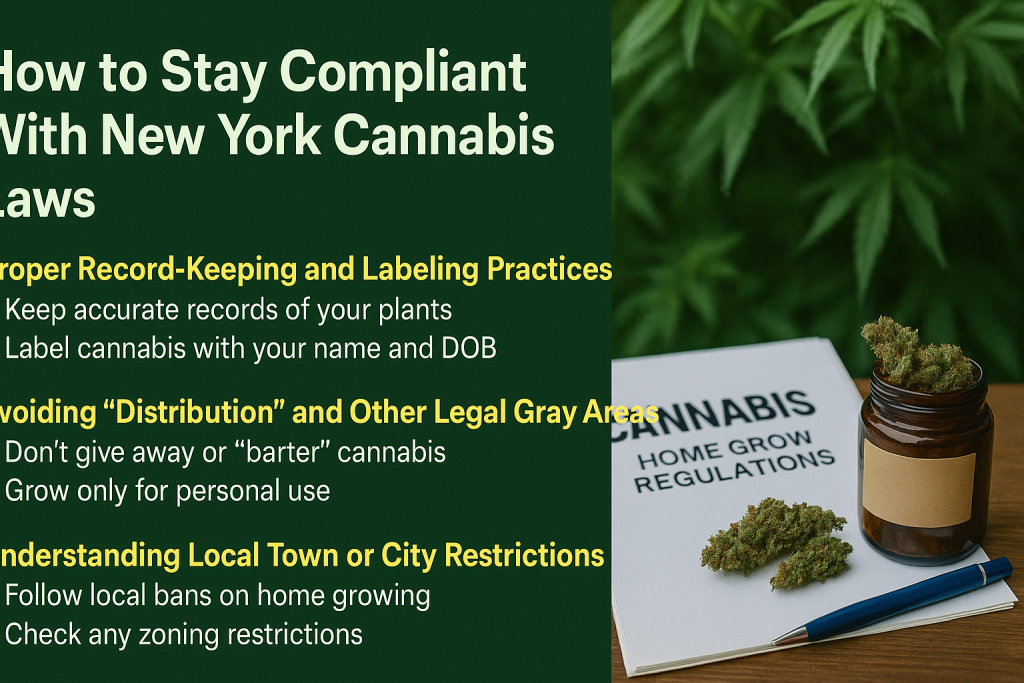
Proper Record-Keeping and Labeling Practices
One of the easiest ways to stay on the right side of New York cannabis laws is to keep track of what you’re doing. If you’re growing at home, don’t just throw plants in the closet and hope for the best. Treat your grow like a small project with real steps and records.
Start by keeping a plant log. Write down the day you planted your seeds, the type of strain, whether the plant is mature or immature, and the grow location inside your home.
Even if no one ever asks to see it, having a written record shows you’re growing responsibly. It also helps you manage plant rotation and stay under the legal limit.
Here’s an example of a simple plant record:
| Plant Name | Date Started | Strain | Stage | Location | Notes |
|---|---|---|---|---|---|
| G13 #1 | 2025-08-01 | G13 Haze | Immature | Closet Tent | Healthy |
| Berry #2 | 2025-08-10 | Blueberry | Mature | Basement | Flowering week 3 |
| Tangie #3 | 2025-08-15 | Tangie | Immature | Closet Tent | Added nutrients |
Along with record-keeping, labeling is strongly recommended. Put a small tag on each plant with your name and birthdate. That helps law enforcement know the plants belong to someone legally allowed to grow.
When you harvest and store the buds, keep the jars or containers labeled, too. Add:
- Your full name
- The strain
- Harvest date
- “Not for sale – personal use only”
These small steps help prove that what you’re doing is legal and not for resale.
Avoiding “Distribution” and Other Legal Gray Areas
Even if you’re doing everything else right, sharing too much cannabis—or the wrong way—can put you in a bad legal spot. New York lets you grow for yourself, but the law draws a hard line between personal use and distribution.
If you give cannabis to a friend, that’s considered gifting, and it’s allowed—but only in small amounts and without anything in return.
Here’s a breakdown of what’s legal and what isn’t:
| Action | Legal? | Details |
|---|---|---|
| Giving a friend up to 3 oz | ✅ Yes | Must be a gift, not a trade |
| Trading weed for goods (barter) | ❌ No | Counts as unlicensed sale |
| Selling any amount | ❌ No | Requires a licensed business |
| Advertising free cannabis | ❌ No | Considered promotion or distribution |
The safest way to share is quietly and in private. You can’t advertise online, set up a stand, or promote your grow—even if you’re not charging.
This is where people slip up. You may not think trading bud for a pizza is a big deal, but legally it could be treated as unlicensed selling.
A local grower in Buffalo explained:
“I gave a friend a couple grams as a gift, and that was fine. But someone else offered to give me a video game in return, and I turned it down. Didn’t want to risk it.”
The law sees money or goods changing hands as a sale—even if you didn’t intend it that way. Staying compliant means keeping your grow and your stash for your personal use only.
Also be careful about how much you store. If you grow more than one harvest and don’t use it all, make sure you’re still under the legal possession limits or you could still face penalties.
Understanding Local Town or City Restrictions
Even though New York cannabis laws allow personal growing, your local government might set their own limits. Towns, villages, and cities can pass zoning laws or building rules that change how you can grow.
Some places may ban outdoor cultivation entirely. Others may require you to register your grow. A few may limit grow lights or ventilation systems due to fire or safety codes.
The Office of Cannabis Management gives statewide rules, but each county or town can adjust how those rules apply in real life.
| Area | Allowed to Grow? | Notes |
|---|---|---|
| Albany | ✅ Yes | Indoor/outdoor allowed, must follow state rules |
| Yonkers | ✅ Yes | Outdoor must not be visible |
| Hempstead | ❌ No outdoor grows | Indoor only with landlord approval |
| Rochester | ✅ Yes | Strong odor control required |
To find out your town’s rules, visit your city’s official website or check local code enforcement offices. You can also call your local building department and ask about cannabis grow zoning.
For people who live in apartments, HOAs, or mobile home parks, other restrictions may apply even if the town says yes. Private landlords and associations can block cannabis grows in leases or community guidelines.
If you live in a restricted area, you still have options:
- Use indoor grow tents to control smell
- Ask your landlord for written permission
- Join local cannabis groups to learn town-specific info
Here’s a quote from a grower in Ithaca:
“Our town doesn’t mind as long as it’s out of sight. I used a blackout tent in my shed with a lock. Never had a problem.”
Following local rules helps protect your grow from complaints and keeps you from getting fined or forced to shut it down.
Also, if your grow affects your neighbors—like strong odors or fan noise—they can report you, and you might have to move or destroy your plants even if you were otherwise legal.
That’s why staying informed about local laws and neighborhood expectations is just as important as knowing the statewide rules under New York cannabis laws. It helps you grow with peace of mind and long-term success.
Safe Storage and Possession Limits
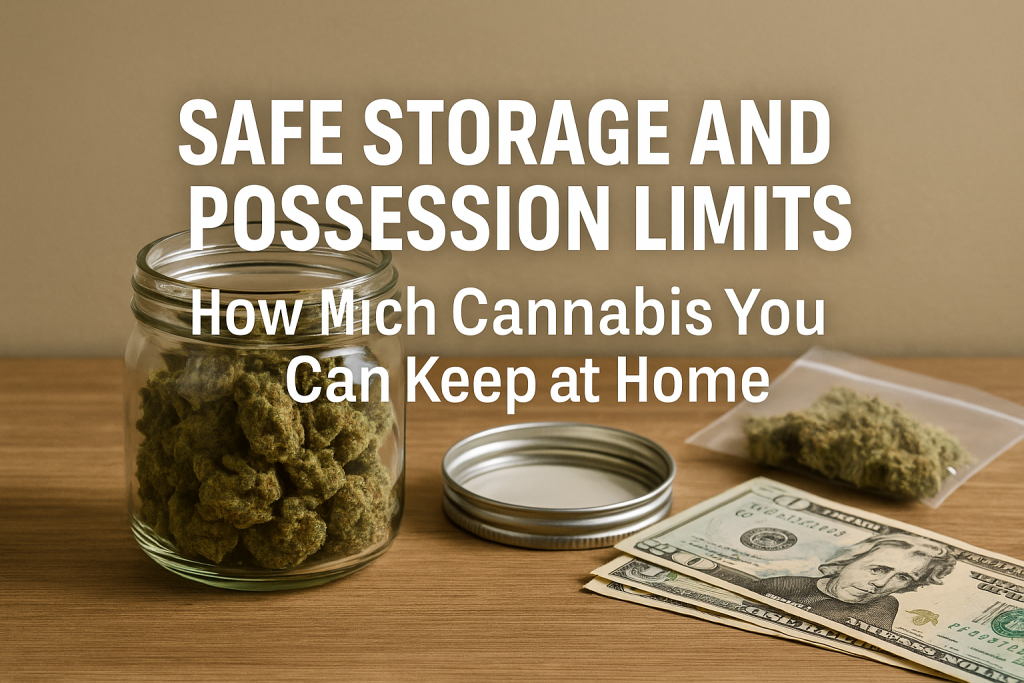
How Much Cannabis You Can Keep at Home
Even though New York cannabis laws let you grow your own weed, you still need to follow rules about how much you can keep. These limits help prove that your cannabis is for personal use, not for selling.
If you’re 21 or older, the law allows you to possess up to 5 pounds of cannabis at home. That might sound like a lot, but if you’re harvesting a few plants at once, it adds up quickly.
The dried flower must be stored in a secure place that’s out of view. That means no open jars on the kitchen counter or bags laying around. Use airtight containers and put them somewhere safe—like a closet, locked cabinet, or storage bin.
Here’s a breakdown of home possession limits:
| Product Type | Max Amount at Home |
|---|---|
| Dried Flower | 5 pounds |
| Cannabis Concentrates | 24 grams |
| Edibles (Infused) | No specific cap, but must be for personal use only |
Just because it’s legal to hold this much doesn’t mean you can carry that amount around in public. The public possession limit is only 3 ounces of flower or 24 grams of concentrates.
One home grower from the Finger Lakes region shared:
“I keep everything in labeled glass jars inside a fire-safe cabinet. No smell leaks, no confusion, and no problems with guests.”
That kind of setup helps keep things organized and stays compliant with the law.
Transporting Cannabis Within New York
If you need to move your cannabis from one place to another—like from your grow area to a friend’s house or just across town—you also have to follow legal transport rules.
Cannabis must be:
- Stored in a sealed container
- Out of reach while driving (like in the trunk)
- Labeled properly if you’re carrying more than a small amount
You can’t drive with an open jar on your passenger seat or smoke while operating a vehicle. Even though it’s legal to have it, cannabis is treated like open alcohol when it comes to cars.
Here’s what’s safe and what’s not:
| Scenario | Legal? | Why |
|---|---|---|
| Cannabis sealed in trunk | ✅ Yes | Out of reach, not in use |
| Open bag on car seat | ❌ No | Treated like open container |
| Smoking while driving | ❌ No | Illegal under DWI laws |
| Delivering to a friend as a gift | ✅ Yes | As long as it’s under 3 oz and not a trade |
It’s also important to stay under public possession limits during transport. That means no more than 3 ounces of dried flower and 24 grams of concentrate outside your home.
If you get pulled over, being able to explain where the cannabis is coming from and how it’s stored can make a big difference. Always stay calm and polite, and don’t carry more than you’re legally allowed.
Some growers also include a small card with each container that says:
- Name
- DOB
- “For personal use only – not for sale”
That extra step helps show you’re following New York cannabis laws to the letter.
Penalties for Unsafe or Excess Storage
If you store more than 5 pounds of cannabis—or keep it in an unsafe spot—you could face serious penalties. Even though home growing is legal, going over the storage limit turns it into a violation.
Here’s what could happen if you’re not careful:
| Violation | Possible Penalty |
|---|---|
| Exceeding 5 lb limit | Fines or plant confiscation |
| Storing cannabis openly | Warnings or local code violations |
| Giving cannabis to minors | Criminal charges |
| Driving with unsealed product | Tickets or DWI-related charges |
The state isn’t out to get personal growers—but they do expect adults to handle cannabis responsibly. That includes keeping it locked away from children, pets, and guests.
You also need to make sure your storage doesn’t lead to complaints. Strong odors, visible containers, or open jars can all attract unwanted attention. Odor-proof containers and locked cabinets solve most of those issues.
A Brooklyn-based grower shared:
“I use mason jars with humidity packs and stash them in a fingerprint-lock drawer. My kids can’t get to them, and it keeps everything fresh.”
Another important point: If you live with other adults, make sure everyone is aware of the limits. If your roommate grows too and you combine your harvests, you might go over 5 pounds without realizing it.
To stay organized, use a simple storage log like this:
| Container Label | Strain | Harvest Date | Weight | Stored Location |
|---|---|---|---|---|
| Jar #1 | Sour Diesel | 09/01/2025 | 1.5 lb | Bedroom Closet |
| Jar #2 | Pineapple Express | 09/10/2025 | 2 lb | Locked Drawer |
| Jar #3 | Gelato #33 | 09/20/2025 | 1.4 lb | Pantry Safe |
That way, if anyone questions you, you can quickly prove that you’re under the limit and storing it safely.
Also, don’t forget that any cannabis waste counts too. Stems, leaves, and trim might seem like trash, but they still count toward your total weight if stored with the usable product.
Following the possession limits outlined in New York cannabis laws keeps your home grow legal and drama-free. Store smart, stay organized, and treat your stash with care just like any other valuable product in your home.
Selling, Sharing, and Gifting Rules
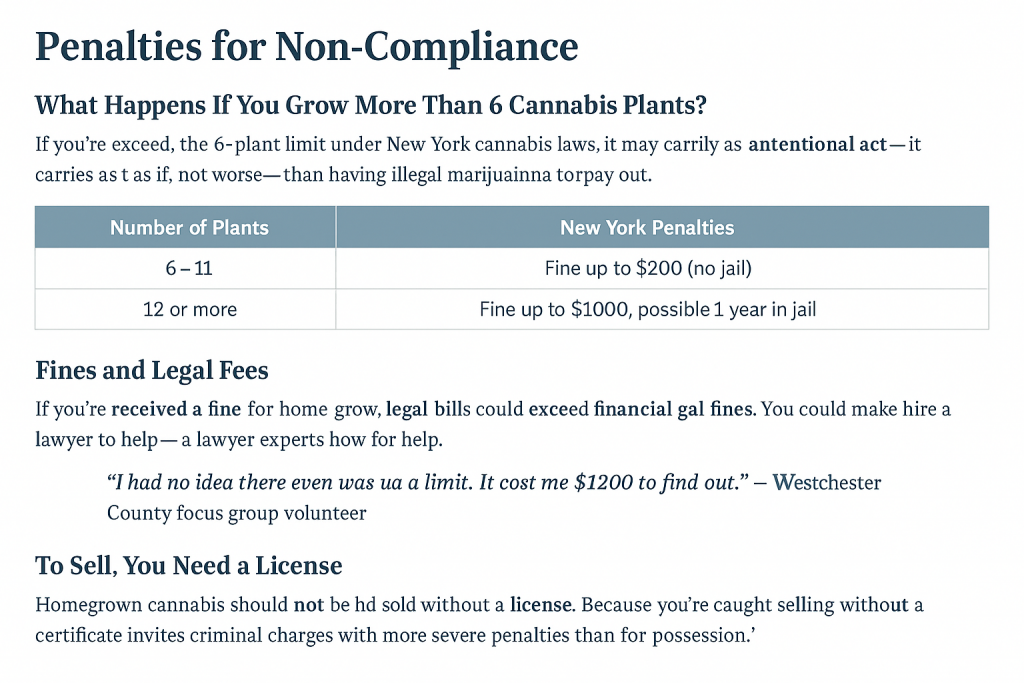
The Legal Way to Share Cannabis With Friends
Under New York cannabis laws, sharing cannabis is allowed—but there are limits. If you’re thinking about handing over some of your homegrown flower to a buddy, it has to be a true gift. That means no strings attached, no trades, and no money exchanged.
You can give another adult up to 3 ounces of cannabis flower as a gift. That adult must be 21 or older, and you can’t advertise the giveaway. You can’t ask for a donation, a favor in return, or try to trade for services.
The moment something is exchanged—even if it’s just a slice of pizza or a car ride—it could be seen as distribution, which is illegal without a license.
Here’s how to stay safe when gifting:
| Action | Legal? | Why |
|---|---|---|
| Giving your friend a small jar of flower | ✅ Yes | Personal gift, no money |
| Swapping for food or items | ❌ No | Considered a trade |
| Posting “free weed” on social media | ❌ No | Looks like public distribution |
| Gifting at private gathering | ✅ Yes | Legal if no sale or trade occurs |
A Rochester-based grower said:
“I label the jar with my name and the date I harvested it. When I gift it to someone, I tell them it’s a personal grow and not for resale.”
That extra step helps you stay compliant with the law and makes your intentions clear.
Sharing concentrates or edibles follows the same rules. It must be under 24 grams of concentrate and still a gift—not a swap or sale.
What Counts as Illegal Sale or Distribution
If you’re giving away cannabis and getting anything in return, it’s not legal. You need a license to sell marijuana in New York. Without one, selling—even small amounts—can lead to fines, arrests, or jail time.
The law defines a sale as:
- Any exchange of cannabis for money
- A trade for goods or services
- Offering cannabis to promote a business
- Repeated gifting that seems like a setup
Even if you don’t think of yourself as a seller, the state might. Gifting to five different people in one weekend could raise red flags. Especially if it’s combined with any kind of online post, flyer, or message.
Here’s a list of red-flag behaviors:
- Saying “free cannabis with T-shirt purchase”
- Offering weed with a “suggested donation”
- Running a private club with entry fees and cannabis access
- Leaving cannabis in public areas for others to pick up
Those moves can trigger distribution charges, even if no cash directly changes hands. New York takes illegal sales seriously, especially since licensed dispensaries are taxed and regulated.
Let’s compare gifting vs. selling:
| Scenario | Legal? | Details |
|---|---|---|
| Give 2 grams to friend on birthday | ✅ Yes | No trade or money involved |
| Trade weed for art or baked goods | ❌ No | Still a transaction |
| Offer free cannabis with event ticket | ❌ No | Considered promotional sale |
| Share cannabis at home with a friend | ✅ Yes | Private gift, not advertised |
Even saying things like “I’ll give you some if you pay for my lunch” crosses the line. Always keep gifting 100% free and personal.
A quote from a Hudson Valley grower:
“I gave my cousin an eighth as a birthday gift, but we didn’t post about it or tell anyone. It’s just better to keep it quiet and personal.”
You don’t have to hide what you’re doing—but you also shouldn’t draw attention by making it look like a transaction.
How to Stay on the Right Side of the Law
To follow New York cannabis laws properly, focus on being clear, private, and personal. If you’re growing for yourself, use it for yourself or share it quietly with trusted adults.
Here’s a simple checklist for safe sharing:
- ✅ Only gift to adults 21+
- ✅ Never ask for or accept money, goods, or trades
- ✅ Limit to 3 ounces per gift
- ✅ Keep it personal—not public or promotional
- ✅ Label all containers clearly
Labeling helps, too. Even though it’s not required by law, writing “Personal Use – Not for Sale” on your container shows you’re being responsible.
And if you plan to give cannabis away often—like to friends or family—keep a small log of what you give and to whom. It’s not required, but it protects you if someone reports you for selling.
Here’s a simple gift log example:
| Date | Recipient | Amount | Type | Notes |
|---|---|---|---|---|
| 08/15/2025 | Mike R. | 1g | Flower | Birthday gift |
| 08/20/2025 | Jess T. | 2g | Edible | BBQ gift bag |
| 08/25/2025 | Leo B. | 1g | Flower | Private share |
To legally sell cannabis in New York, you need to be approved by the state and get a license. That process includes background checks, taxes, and full regulation.
If you’re not licensed, don’t sell. Even a small transaction can lead to fines or criminal charges. Focus on personal use, and your grow will stay legal and stress-free.
New York wants people to enjoy legal cannabis safely. As long as your sharing is truly a gift and you’re not running a business out of your house, you’re in line with the law. Following these rules helps protect you, your friends, and your grow.
Home Growing Equipment and Legal Safety Tips
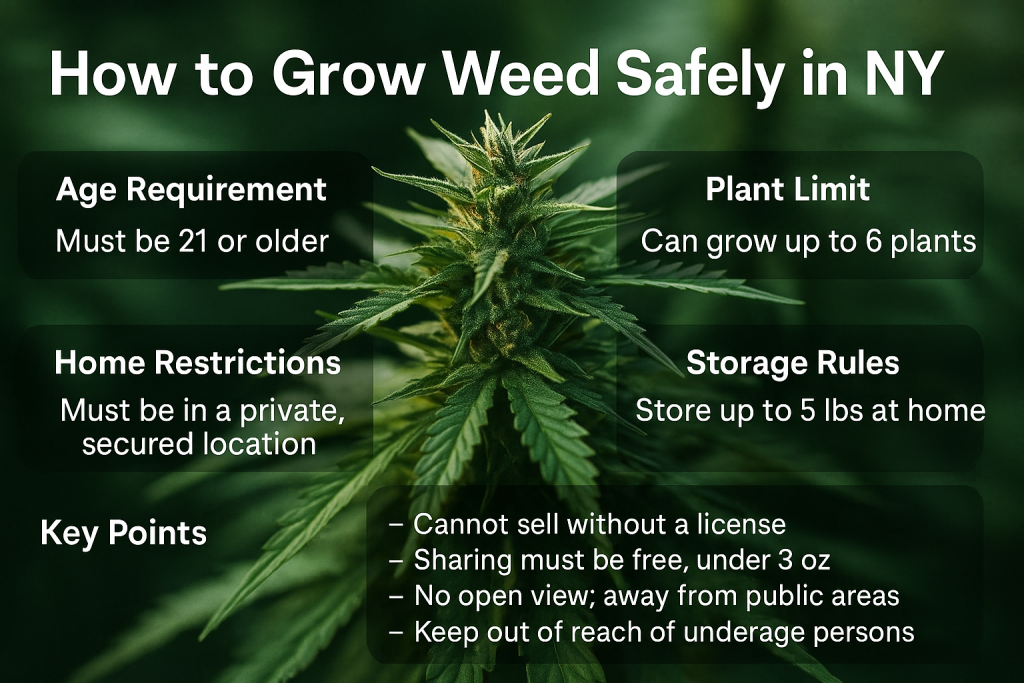
Using Approved Growing Equipment and Power Sources
If you’re growing cannabis at home in New York, you’ve got to keep things safe. Following New York cannabis laws isn’t just about how many plants you have—it’s about how you grow them, too.
Start by using equipment designed for home growing. That means indoor grow tents, LED grow lights, and proper timers. Avoid building your own lighting system or messing with homemade wiring. Anything plugged into your wall must be UL-rated or approved for household use.
Don’t overload outlets. Cannabis plants need light cycles, so grow lights run for hours each day. Plugging multiple high-powered devices into one outlet can cause overheating or even fire.
Use this list to keep your setup safe:
- LED grow lights with low heat output
- Surge protectors with built-in circuit breakers
- Timer-controlled outlets for lights
- Small ventilation fan or carbon filter
- Humidifier or dehumidifier (if needed)
Never use old extension cords or plug multiple power strips into each other. That’s how electrical fires start.
Here’s a simple gear checklist for safe growing:
| Equipment | Why It Matters |
|---|---|
| LED Grow Light | Energy efficient, low heat |
| Grow Tent | Contains light, smell, moisture |
| Carbon Filter | Removes smell from the air |
| Inline Fan | Prevents mold and keeps air moving |
| Surge Protector | Stops power surges or overheating |
Using quality tools helps your plants and keeps your home out of danger.
One grower from Albany said:
“I used a cheap light the first time. It burned out in three weeks and almost melted my extension cord. I learned fast—buy quality gear.”
Preventing Fire Hazards and Electrical Issues
Keeping your home safe while growing cannabis starts with power awareness. Many issues that lead to accidents involve bad wiring, heat, or water near plugs.
Separate your electrical and water zones. Never spray or water near extension cords. Run cords above or behind—not across—the floor to avoid tripping or spills.
Don’t cover your lights or power supplies with blankets or towels. Tents trap heat, and those extra layers can turn into fire starters.
Follow these electrical safety tips:
- Keep cords off wet floors
- Don’t run wires under rugs
- Replace frayed or damaged cords
- Use fans to manage temperature buildup
- Install smoke detectors nearby
You might not think a small indoor grow setup can be risky, but it can. Plants need heat and humidity—so you’ve got to monitor both.
Here’s a breakdown of the risks and ways to prevent them:
| Risk | Prevention |
|---|---|
| Overheated grow lights | Use LEDs, don’t cover vents |
| Too many devices in one outlet | Use separate circuits |
| Leaks near outlets | Place catch trays under pots |
| Poor air circulation | Use exhaust fans or open vents |
If you live in an apartment or old building, check how many amps your outlets can handle. A good rule is: don’t plug more than one major grow item into a single outlet.
A grower in Binghamton shared:
“My breaker kept flipping. Turned out my tent light and fan were pulling too much from one wall socket. I split them between outlets on opposite walls and it fixed the issue.”
That kind of small adjustment can make your setup both safe and legal.
Staying Discreet and Avoiding Neighbor Complaints
Just because growing is legal doesn’t mean everyone around you will be okay with it. One part of following New York cannabis laws is being mindful of smell, noise, and visibility.
Cannabis plants can smell strong. If you’re growing indoors, the odor might seep into shared hallways, vents, or outside windows.
Use carbon filters and smell-proof containers to help. These scrub the air before it exits your grow tent. Most plug right into a small inline fan.
Here’s a simple setup that keeps you discreet:
| Tool | Purpose |
|---|---|
| Grow Tent | Hides plants and blocks light |
| Carbon Filter | Removes strong smells |
| Inline Fan | Moves filtered air out |
| Noise Dampener | Silences fan sound |
| Blackout Curtains | Keeps glow hidden from outside |
If you’re growing outdoors, make sure your plants can’t be seen from the street. A tall fence, hedge, or greenhouse cover helps block views.
Some towns have laws about odor and visibility. Even if you’re under the plant limit, a neighbor complaint could trigger a visit from code enforcement.
Here are the most common complaints people file:
- “It smells like skunk all day.”
- “I see plants from the sidewalk.”
- “There’s a weird noise coming from next door.”
- “I think they’re growing weed in the garage.”
You can stop those complaints before they start by keeping your setup quiet and sealed. Most issues come down to smell and light—not the plants themselves.
Quotes from local forums show how growers stay low-key:
“I added weatherstripping around my tent door. It stopped all the smell leaks.”
“My landlord didn’t care once I put a filter in. Now even my roommate can’t smell it.”
Staying discreet isn’t about hiding from the law—it’s about avoiding drama. You have the right to grow, but it’s smart to protect your space and your relationships with others around you.
If you follow basic safety rules, choose proper equipment, and keep your operation low-key, you’ll be fully compliant with New York cannabis laws and grow confidently in peace.
What to Do If Law Enforcement Visits
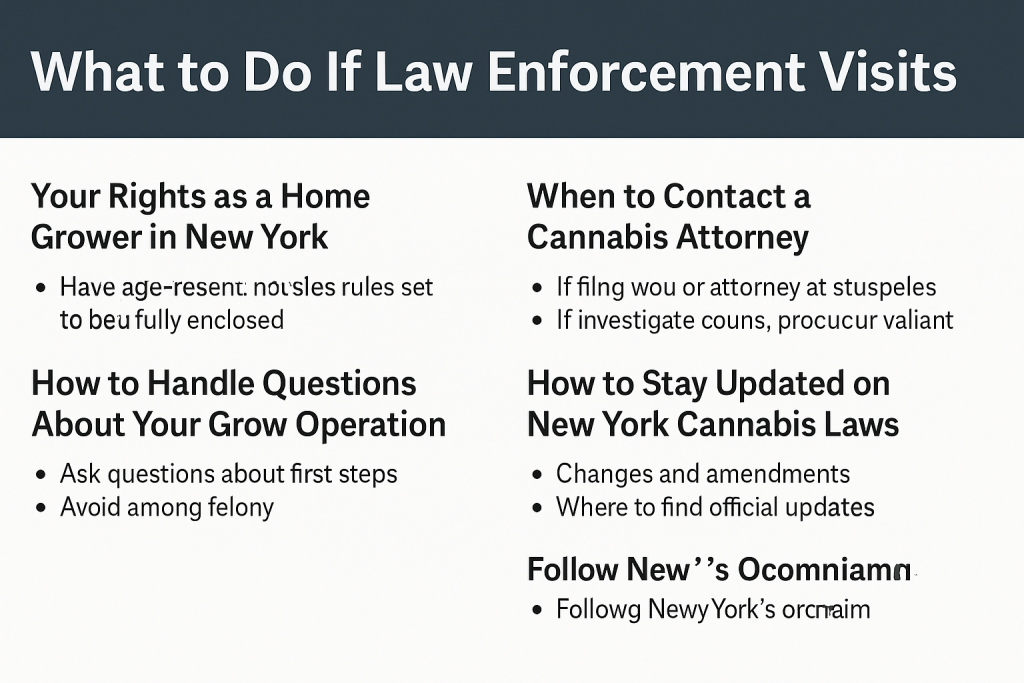
Your Rights as a Home Grower in New York
Even though New York cannabis laws allow personal growing, you still have legal rights if law enforcement shows up at your home. The most important thing to know is that you do not have to let officers inside without a warrant. Growing cannabis legally doesn’t take away your basic constitutional rights.
If police knock on your door, stay calm. Open the door slightly, step outside if you feel comfortable, and speak politely. Don’t argue, but also don’t invite them in unless they show you a search warrant signed by a judge. A badge or ID card alone is not enough to enter your property.
Here’s a quick summary of your key rights:
| Right | What It Means |
|---|---|
| Right to Privacy | Police can’t enter your home without a warrant or consent |
| Right to Remain Silent | You don’t have to answer detailed questions |
| Right to Legal Representation | You can request an attorney before answering |
| Right to Refuse a Search | You can say no to voluntary searches |
If officers say they smell cannabis, that’s not automatically cause for entry. Since cannabis is now legal for personal use, the smell alone doesn’t prove anything illegal. Stay respectful, but stand firm on your right to privacy.
A grower from Kingston once said:
“They knocked because of a smell complaint. I asked for a warrant politely and showed them my state ID. They left after five minutes. It was nerve-racking, but I stayed calm.”
That kind of response keeps you protected and shows confidence in your legal rights.
If officers present a warrant, read it carefully. It should state exactly what they’re allowed to search and why. You can also call an attorney before letting them proceed.
How to Handle Questions About Your Grow Operation
If police or code officers ask about your grow, keep your answers short, truthful, and polite. You can confirm basic things—like your age and that you’re growing for personal use—but avoid giving unnecessary details.
Here’s how to handle common questions:
| Question | Safe Response |
|---|---|
| “Are you growing marijuana here?” | “Yes, for personal use under New York law.” |
| “Can we take a look?” | “Not without a warrant, thank you.” |
| “Who else lives here?” | “I live here with other adults who are also over 21.” |
| “How many plants do you have?” | “Within the legal limit allowed by state law.” |
You don’t have to show your plants unless they have a search warrant. Never lie, but you also don’t need to volunteer more than the basics.
If they say they’re investigating a smell or complaint, it’s best to show your New York ID and calmly confirm you’re growing within the legal limits. You don’t need to invite them in to prove it. A polite tone and confident stance go a long way.
Avoid saying things like “I think I might have a few extra plants.” That kind of admission could lead to inspection or confiscation. If you’re unsure about a rule, say you’d like to check your records or contact your lawyer first.
Here’s what to do if things feel tense:
- Stay calm and avoid sudden movements.
- Keep your hands visible.
- Don’t argue or raise your voice.
- Ask clearly, “Am I being detained, or am I free to go?”
- Write down the officers’ names and badge numbers if possible.
After they leave, make notes about what happened—the date, time, and what they said. This helps if you need to discuss it later with a lawyer.
Many New Yorkers use cameras or smart doorbells now. If your conversation was recorded, save that video as evidence. It’s legal to record interactions at your own home.
When to Contact a Cannabis Attorney
If you’re ever unsure about your rights—or if police take any of your plants or issue a citation—contact a cannabis attorney immediately. These lawyers specialize in New York cannabis laws and can help you understand your situation before it becomes serious.
Here’s when to call one:
- Police entered or searched your home
- Your plants or equipment were taken
- You received a ticket or warning
- You’re accused of selling or distributing
- You’re facing eviction due to your grow
Don’t wait until after things escalate. A lawyer can explain how your rights under the Marijuana Regulation and Taxation Act (MRTA) protect you. Many offer free consultations and will walk you through what to say—and what not to.
If you don’t know any local attorneys, you can search through the New York State Bar Association or contact local legal aid groups that focus on cannabis-related cases. They can help verify whether law enforcement followed the correct process.
When you talk to your attorney, bring these things:
- Your grow log or plant records
- Photos of your setup (if legal)
- Notes from any law enforcement visit
- Copies of your ID and lease agreement
- Any written warnings or paperwork
A real quote from a grower in Buffalo summed it up best:
“Having a lawyer’s number in my phone gave me peace of mind. I never needed it, but I knew what to do if something happened.”
That’s the goal—to be ready without fear. New York made growing cannabis legal, but that doesn’t mean confusion or misunderstanding can’t happen. Knowing your rights, keeping things documented, and getting legal advice early will keep you fully protected under New York cannabis laws.
How to Stay Updated on New York Cannabis Laws
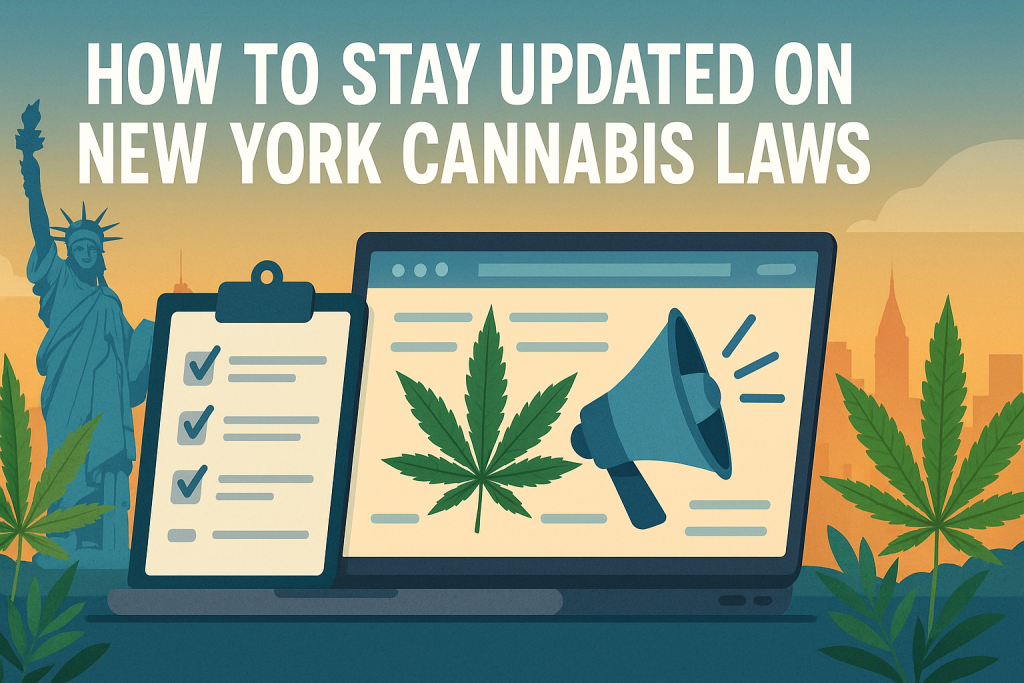
Changes and Amendments in State Law
Cannabis laws in New York are not set in stone. They change, sometimes quickly. If you’re growing cannabis at home, keeping up with these updates is just as important as watering your plants.
One of the first things I did after starting my own grow was set up alerts. News sites, local advocacy groups, and legal blogs often push out updates when laws shift. I made a habit of checking these a couple times a month.
Some changes are minor. Maybe it’s how many plants you can grow indoors. Others are major—like zoning rules or changes in penalties.
New York’s cannabis rules are overseen by the Office of Cannabis Management. They’re the folks making sure growers, dispensaries, and patients are all playing by the same rules.
Below is a list of types of law changes that could affect home growers directly:
| Type of Change | How It Affects You |
|---|---|
| Plant Limit Adjustments | You may be allowed more or fewer plants |
| Storage Regulations | Changes how and where you can store weed |
| Zoning Law Shifts | Some areas may ban growing altogether |
| Security Requirements | New rules might require fencing or locks |
| Penalty Revisions | Fines or criminal penalties could increase |
| Caregiver Program Changes | Who can help you grow may be restricted |
These rules don’t change every week, but they evolve. Sometimes it happens through new bills, other times through updated interpretations or court cases.
Where to Find Official Updates and Announcements
Relying on Facebook or Reddit for updates might leave you behind—or misinformed. To get straight info, I use official channels and advocacy groups based in New York.
Here are reliable sources to check:
- New York State Senate Bill Tracker: You can follow pending and passed cannabis laws here.
- New York Cannabis Insider: A solid local news source focused on marijuana business and laws.
- Leafly’s New York cannabis section: They often post updates about policy shifts specific to NY.
Each of these can be bookmarked or even set up for email alerts. If you’re more old-school, check your local county board or town council site. Some counties release public bulletins when new rules go into effect.
A great tip I picked up was using RSS feeds. If a site like the OCM or Senate updates their news, I get a ping right on my phone. That way, I’m not blindsided when a change takes effect.
Here’s a weekly check-in schedule that’s worked for me:
| Task | Time Needed | How Often | Resource Example |
|---|---|---|---|
| Read local cannabis news | 15 mins | Weekly | NY Cannabis Insider |
| Review OCM announcements | 10 mins | Monthly | OCM Home Page |
| Scan new laws | 20 mins | Monthly | NY Senate Tracker |
| Community forum updates | 20 mins | Weekly | Local Facebook groups / Discord servers |
Following New York’s Office of Cannabis Management (OCM)
The Office of Cannabis Management is your best friend and watchdog rolled into one. They’re responsible for all things cannabis in the state—licenses, regulations, consumer protection, and public health education.
Their site is packed with info. It’s where I got the home cultivation guidelines and downloaded a printable copy to keep by my grow tent. They even host webinars and town halls that cover updates or new enforcement efforts.
I recommend following them on Twitter/X or signing up for their email list directly through the OCM updates page. That way, if new rules drop—like changes to home storage or plant count—you’ll hear it straight from the source.
Here are specific tools and resources the OCM provides that have helped me stay compliant:
- Printable Home Grow Checklists
- FAQs Section for adult-use and medical cannabis
- Guidance Bulletins for interpreting confusing rules
- Local Board Links to see how your town interprets state law
Quotes from the OCM public webinars have helped clear up confusion, especially about gray areas. For example:
“Growing cannabis at home is a right, but like any right, it comes with responsibilities. Proper storage and respect for local laws are critical.” – OCM Legal Advisor, Public Webinar, 2024
For folks growing with roommates or in multi-family housing, the OCM also addresses questions on leases and how to avoid conflicts with neighbors or landlords.
Another thing I picked up: anytime the OCM changes something, they issue a bulletin. If you’re on their list, you’ll get it in your inbox the same day. I saved those emails in a folder called “Weed Laws” so I can find them when I need them.
| OCM Tool or Service | What It Helps With |
|---|---|
| Email Alerts | Immediate notice of law changes |
| Public Webinars | Direct info from OCM staff |
| Cannabis Board Meeting Notes | Transparency into pending decisions |
| Consumer Protection Pages | Understanding product labeling rules |
| Legal Notices Archive | All previous law updates in one place |
The laws around cannabis in New York might look chill at first, but they’re wrapped in layers of regulation. I’ve found that staying current means fewer headaches and no surprises. Just a little time every week saves a lot of time, money, and stress later.
Common Mistakes Home Growers Make
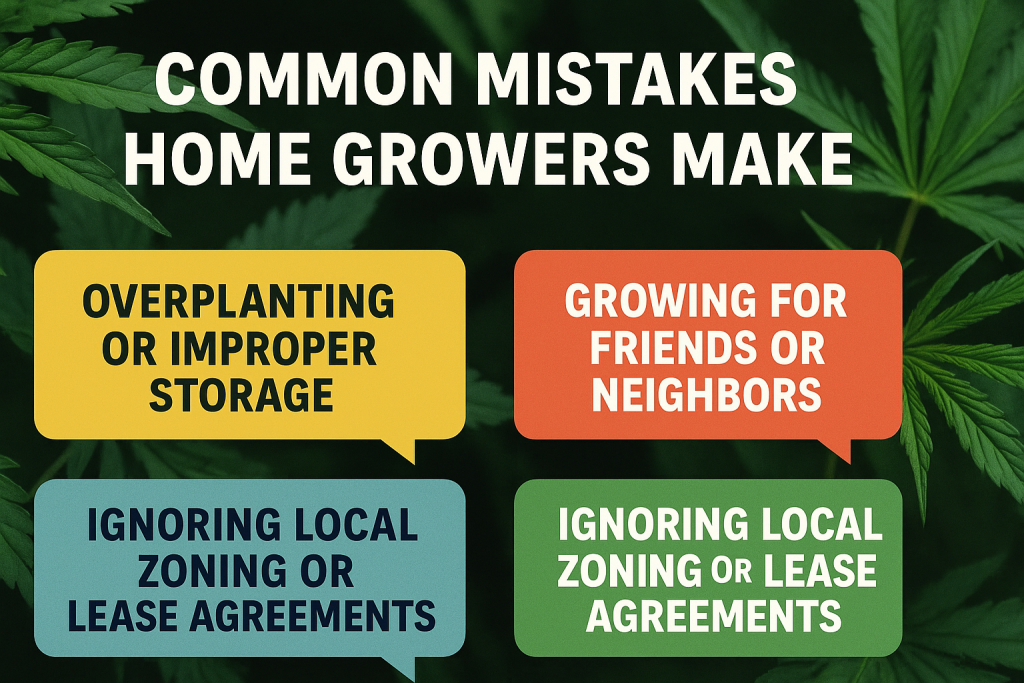
Overplanting or Improper Storage
Even with New York cannabis laws on your side, growing too many plants is one of the fastest ways to break compliance. It might seem harmless to start a few extra “just in case,” but once those seedlings mature, you could accidentally exceed the six-plant limit for adults—or twelve per household. That’s enough to trigger penalties under state regulations.
It’s best to label every pot or tag each plant with its growth stage. Keeping a simple grow log helps, especially if you’re ever asked to prove compliance. I use a whiteboard in my grow room that lists each plant’s start date and whether it’s mature or immature. It keeps everything clean and traceable.
Improper storage is another big mistake. Dried cannabis must be kept in a secure, childproof container, away from public view. Leaving jars on your kitchen counter might seem convenient, but it can easily lead to violations if anyone under 21 has access.
Here’s a breakdown of proper and improper storage methods:
| Storage Method | Legal? | Notes |
|---|---|---|
| Airtight glass jar, labeled, stored in cabinet | Yes | Meets OCM guidelines |
| Plastic bag left out on counter | No | Risk of access by minors |
| Locked storage box | Yes | Ideal for families or shared housing |
| Refrigerator storage | Yes, if sealed | Avoid moisture exposure |
| Open container in car | No | Illegal to transport open cannabis |
Keeping your harvest safe protects not just your stash but also your rights under New York cannabis laws.
A grower from Rochester said:
“I thought keeping buds in mason jars on the shelf was fine until my niece visited. I switched to locking boxes and never worried again.”
Simple adjustments like that make all the difference.
Growing for Friends or Neighbors
Another major pitfall is growing cannabis for others. Even if it’s for a friend, neighbor, or relative, it’s illegal to cultivate plants for anyone else without a state license. The Marijuana Regulation and Taxation Act (MRTA) allows personal use only—meaning what you grow must be for you and other adults in your household.
Sharing or “gifting” small amounts of dried flower (up to three ounces) is legal, but producing cannabis for someone else to consume crosses into distribution territory. That’s where legal trouble begins.
Here’s a quick comparison between what’s allowed and what’s not:
| Activity | Legal? | Notes |
|---|---|---|
| Growing up to 6 plants for personal use | Yes | Legal for adults 21+ |
| Giving 1–3 oz to a friend | Yes | Must be free, no payment or trade |
| Growing plants for a friend | No | Considered unlicensed cultivation |
| Trading cannabis for goods | No | Treated as illegal sale |
| Charging for growing help | No | Requires grower license |
Even “helping out” a friend by keeping their plants at your house counts as growing for someone else. If both of you are over 21, they can legally grow their own plants at their residence. It’s better to coach them than risk breaking the law for them.
A small grower from Long Island shared:
“I tried to keep plants for my buddy while he moved apartments. We thought it was harmless. Turns out that could’ve been seen as illegal growing for another person.”
The best way to stay compliant is to grow your own and stop there. Everyone 21 and up can grow for themselves, so it’s easy to stay within your rights.
Ignoring Local Zoning or Lease Agreements
Even if state law says you can grow cannabis, your town or landlord might say otherwise. Local zoning laws or lease terms often restrict cultivation in certain types of housing or neighborhoods.
If you live in an apartment, check your lease before planting anything. Many property managers include a “no cultivation” clause to protect against potential fire hazards, water leaks, or insurance issues. Breaking that rule can lead to eviction—even if you’re within state limits.
Here’s how local rules can vary:
| Housing Type | Restrictions You Might Face |
|---|---|
| Private Home (Owned) | Usually unrestricted if not visible to public |
| Rental Apartment | Lease may ban growing or smoking |
| Shared Housing | Landlord or HOA may impose limits |
| Co-op or Condo | Often subject to community board rules |
| Rural Property | May have looser or no restrictions |
Before I set up my first grow tent, I checked my county zoning board’s website and my homeowner’s insurance policy. Both required that the setup be indoors and out of public view. Following that saved me a ton of headaches.
If you’re unsure about your area, reach out to your local zoning office or the New York Department of State Division of Local Government Services. They can tell you exactly what’s allowed where you live.
Some growers install greenhouses to keep plants secure and out of sight. As long as the structure is locked and not visible from the street, it typically meets New York cannabis law requirements. Just be sure your zoning rules allow it before building.
A grower in Syracuse shared:
“I didn’t know my lease banned any kind of cultivation. My landlord gave me a warning after smelling it in the hallway. I moved my setup to my brother’s house and now I’m fine.”
Mistakes like that can happen fast, but checking your paperwork first avoids big problems later.
Growing cannabis in New York can be rewarding, but it’s not as simple as planting a seed and waiting. Staying within limits, following your lease, and growing only for yourself are the cornerstones of safe, legal home cultivation.
How New York Cannabis Laws Protect Home Growers
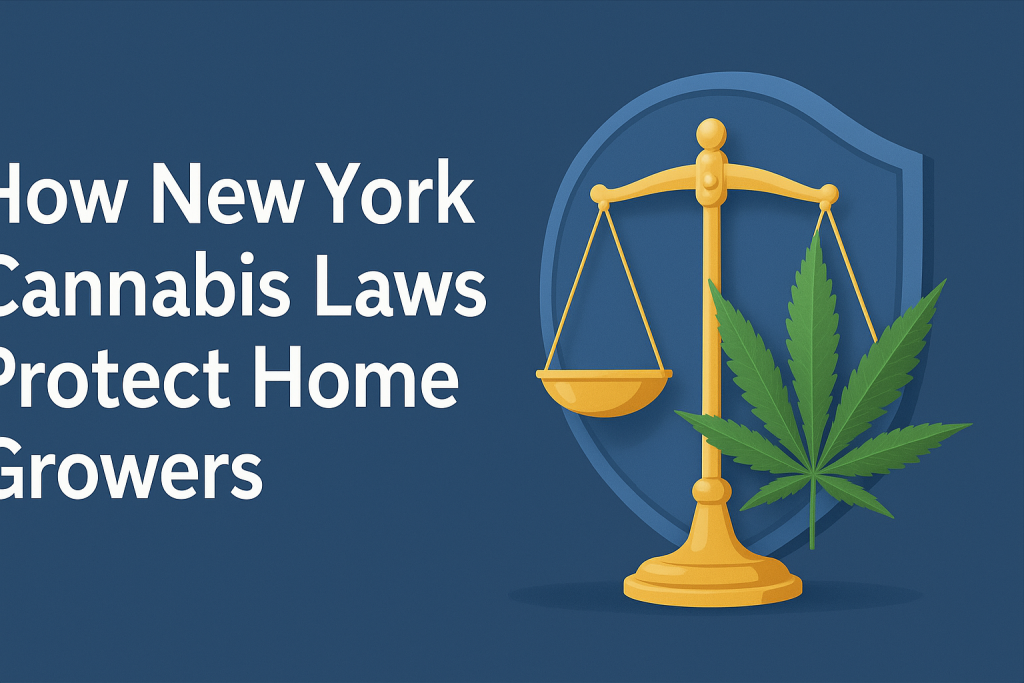
Your Rights Under the Marijuana Regulation and Taxation Act (MRTA)
The Marijuana Regulation and Taxation Act (MRTA) gives New Yorkers the right to grow cannabis safely and legally at home. It’s one of the most significant protections for adults who want to cultivate their own plants without fear of arrest or heavy fines. Under this law, any adult over 21 can grow cannabis for personal use, as long as they stay within the plant limits and follow local safety guidelines.
Before the MRTA, even a single plant could get someone charged with possession or intent to distribute. Now, the law separates home growers from commercial producers, creating space for personal cultivation. That means your small grow tent or garden is recognized under the law as a personal project, not a criminal act.
Here’s a quick breakdown of what the MRTA allows:
| Right | Description |
|---|---|
| Home Cultivation | Up to six plants per adult, twelve per household |
| Personal Possession | Up to three ounces of flower or 24 grams of concentrate |
| Privacy Protection | Police cannot search your home without a warrant |
| Medical Patient Rights | Patients may grow more plants with certification |
| Sharing Privileges | Gifting up to three ounces is permitted, no sales |
The MRTA doesn’t just legalize cannabis—it outlines your protection as a grower. It ensures your right to use, possess, and grow cannabis is shielded from discrimination, whether from landlords, employers, or public officials.
One grower from Albany explained:
“When I first started, I was nervous. But once I read through the MRTA, I realized the law was written to protect small home growers like me.”
That sense of safety is what makes the MRTA a cornerstone of cannabis reform in New York.
Legal Protections for Personal Use
If you grow within legal limits, New York law provides you with clear protections. You can’t be arrested, fined, or discriminated against simply for cultivating cannabis at home. That’s a major step forward compared to older laws that criminalized even trace amounts of marijuana.
Under these protections, cannabis is treated much like alcohol for adults—something you can produce and enjoy responsibly. Law enforcement must respect that difference, and your personal use is protected by law.
For example, a police officer cannot seize your plants or product if you are within the legal plant count and possession limit. Similarly, employers and landlords cannot punish you solely for legal use or cultivation. However, they can enforce safety rules or non-smoking policies if they apply to all tenants.
To help understand how these protections apply, here’s a quick guide:
| Situation | Protected Under MRTA? | Notes |
|---|---|---|
| Growing up to six plants | Yes | Legal for adults 21+ |
| Sharing with friends (no payment) | Yes | Up to three ounces |
| Selling or trading | No | Requires a license |
| Possessing more than 3 oz | No | Still illegal |
| Fired for legal use at home | Yes (protected) | Employer must show legitimate reason |
If your rights are ever violated—say a landlord threatens eviction or an employer takes action against you—reach out to a cannabis rights attorney. Organizations like the Legal Aid Society of New York offer free or low-cost advice for cases like this.
Legal protections also extend to law enforcement behavior. The smell of cannabis is no longer considered probable cause for a search. That single change has stopped countless unnecessary arrests since legalization began.
The MRTA even protects medical users more deeply. Registered medical patients and caregivers can grow more plants, as long as they’re properly documented through New York’s Medical Cannabis Program. You can review those patient rights on the New York State Department of Health’s medical cannabis page.
What Police Can and Can’t Do
Even though home cultivation is legal, it’s still important to understand how law enforcement fits into the picture. Police officers can enforce the law—but they also must respect your rights under the MRTA.
Here’s what they can do:
- Investigate complaints from neighbors about strong odors or visible plants
- Request proof of age if cannabis use is visible in public
- Enforce limits on possession or unlicensed sales
- Enter your home only with a signed search warrant
Here’s what they can’t do:
- Enter your home without consent or warrant
- Seize legal plants grown within limits
- Arrest you for smell or personal possession
- Force you to answer questions about your grow
If officers visit, be polite but firm. Ask to see a warrant, and if they don’t have one, tell them you prefer not to answer questions without an attorney. That’s your constitutional right, and New York’s cannabis laws support that stance.
A Bronx grower once shared his experience:
“They came because a neighbor complained about the smell. I stayed calm, told them I was within my rights, and they left. I didn’t even have to show my plants.”
That story reflects what’s happening all over the state—growers learning the law and standing on solid legal ground.
If an officer ever confiscates your cannabis without cause, document everything immediately. Write down the date, time, officer’s name, and what was taken. Then contact a civil rights attorney or the New York Civil Liberties Union for help.
New York’s cannabis reform was designed to protect citizens from the overreach that defined the war on drugs for decades. The MRTA doesn’t just legalize cannabis—it sets up a framework of fairness. It treats home growers as responsible adults, not criminals.
Knowing your rights means you can grow with confidence. New York cannabis laws were written to support responsible cultivation, respect personal freedom, and keep enforcement balanced and fair.
Conclusion: Growing Safely and Legally in New York
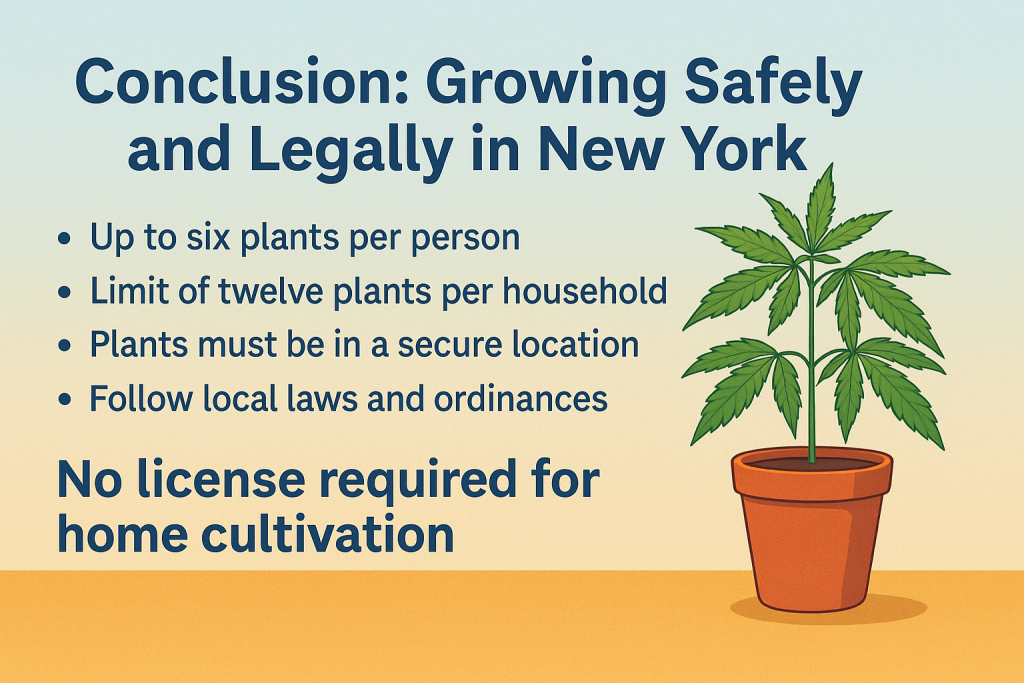
Following New York cannabis laws means more than just counting your plants. It’s about creating a safe, private space where your grow thrives within the rules. Whether you’re a first-time grower or experienced with horticulture, staying compliant ensures peace of mind and protection under state law.
Home growing is about balance—understanding what’s allowed while avoiding simple mistakes. Six plants per adult, twelve per household, is the limit. Keep them secured and out of public sight. A locked grow tent, small greenhouse, or enclosed yard meets the law’s standards. If you live with kids or visitors, make sure your setup includes childproof containers and clear labeling for harvested cannabis.
Here’s a quick summary of compliance essentials:
| Requirement | What You Should Do |
|---|---|
| Plant Limit | 6 per adult (3 mature, 3 immature), 12 max per household |
| Storage | Keep cannabis in sealed, child-resistant containers |
| Visibility | Plants must not be seen from public areas |
| Sharing | You can gift up to 3 ounces, but not sell or trade |
| Residency | Grow only in your primary residence |
| Security | Use locks or enclosed spaces to limit access |
The state’s Office of Cannabis Management encourages responsible cultivation. Their guidelines show that the goal isn’t punishment—it’s safety, awareness, and respect for community standards.
A grower from Binghamton once said:
“Once I followed every rule—secured my tent, labeled jars, logged my plants—I stopped worrying. It felt like any other hobby I enjoy at home.”
That mindset is what the law promotes: freedom with accountability.
Growing cannabis in New York gives residents independence. You can choose strains, manage your harvest, and control what you consume—all within a legal framework. When done right, it becomes both relaxing and rewarding.
Frequently Asked Questions
Q1. Can I grow cannabis in my backyard in New York?
Yes, if it’s fully enclosed and not visible to the public. You must also follow the plant limit and local ordinances.
Q2. Do I need a license to grow cannabis at home in New York?
No license is needed for personal use, but you must meet age and residency rules and follow plant limits.
Q3. How many cannabis plants can I grow legally in New York?
Adults 21+ can grow up to six plants (three mature, three immature). A household can have up to twelve total.
Q4. Is it legal to give homegrown cannabis to friends?
Yes, you can gift up to three ounces as long as it’s not part of a sale or trade.
Q5. What’s the penalty for breaking New York’s cannabis growing laws?
Penalties can include fines, confiscation of plants, or criminal charges for distribution or overproduction.

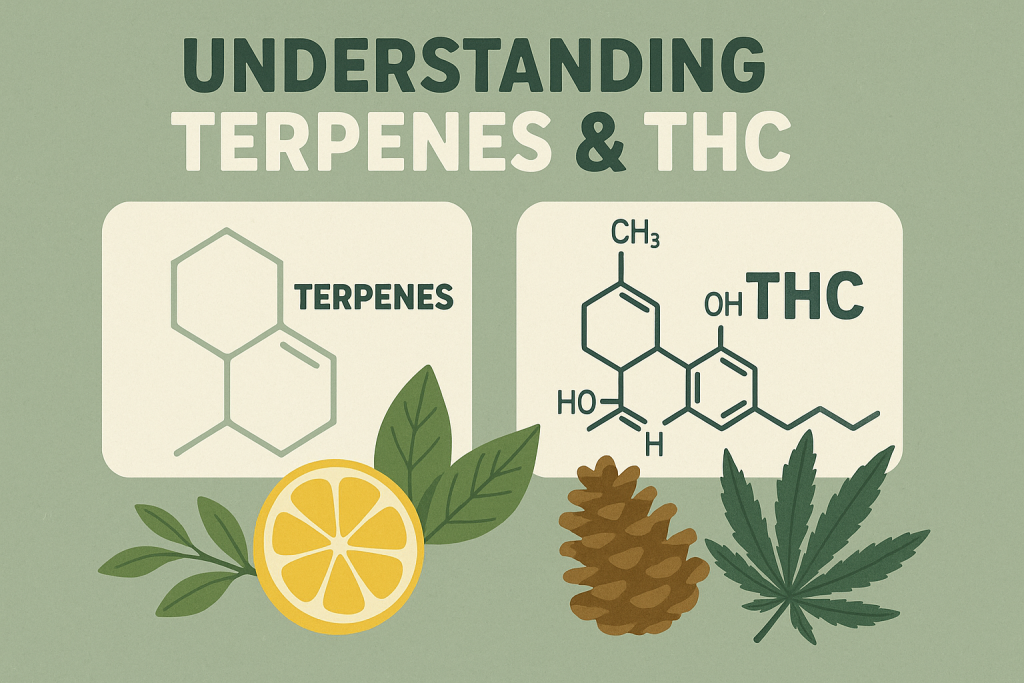
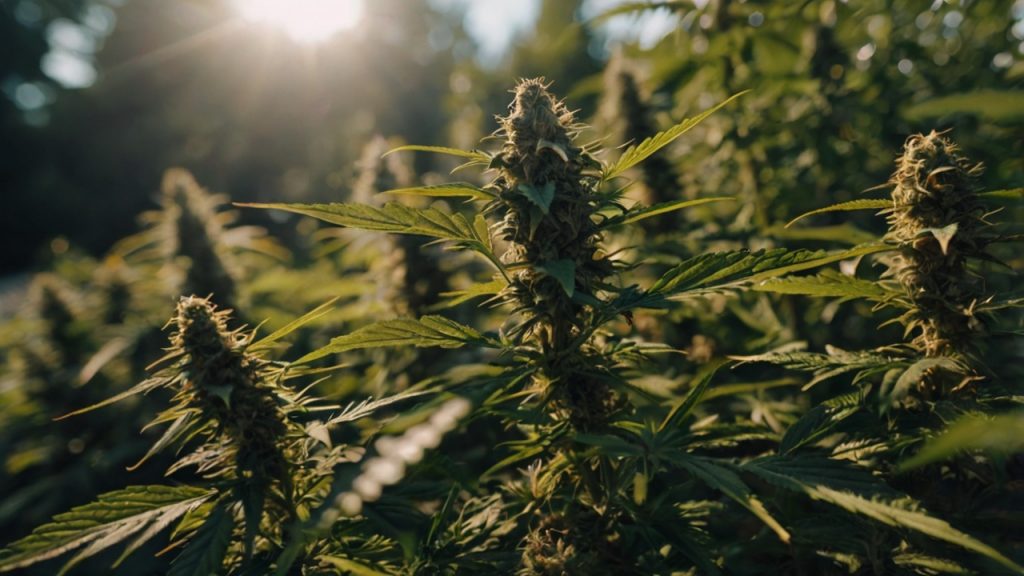
Responses